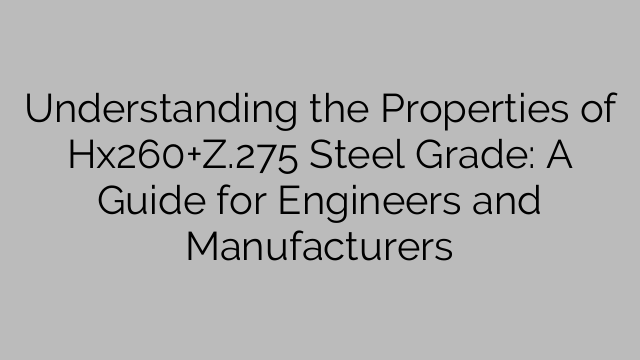Understanding the Properties of Hx260+Z.275 Steel Grade: A Guide for Engineers and Manufacturers
Steel is one of the most widely used materials in the industrial and construction sectors, with numerous grades and specifications available to meet specific requirements. One such grade is Hx260+Z.275, which is a hot-dip galvanized steel with a zinc coating thickness of 275 grams per square meter. This grade is commonly used in manufacturing and construction due to its excellent mechanical properties and corrosion resistance. Understanding the properties of Hx260+Z.275 steel grade is essential for engineers and manufacturers to ensure its proper application and performance.
Mechanical Properties
Hx260+Z.275 steel grade has a high tensile strength of 260 megapascals, making it suitable for structural and load-bearing applications. Its yield strength is approximately 260-365 megapascals, providing good ductility and formability for various fabrication processes. The elongation at break is typically 20-25%, indicating its ability to undergo deformation without fracturing. These mechanical properties make Hx260+Z.275 steel grade suitable for a wide range of engineering and manufacturing applications, including automotive components, building structures, and industrial machinery.
Corrosion Resistance
The zinc coating on Hx260+Z.275 steel grade provides excellent corrosion resistance, protecting the base metal from oxidation and rusting. The zinc layer acts as a barrier, preventing moisture and corrosive substances from reaching the steel substrate. This makes Hx260+Z.275 steel grade ideal for outdoor and marine applications, where exposure to harsh environmental conditions is common. Additionally, the galvanized coating provides sacrificial protection, meaning that even if the coating is scratched or damaged, the zinc will continue to corrode before the steel substrate, prolonging the lifespan of the material.
Welding and Fabrication
Hx260+Z.275 steel grade is well-suited for welding and fabrication processes due to its excellent formability and weldability. Manufacturers can easily cut, bend, and shape this material to create complex components and structures. When welding Hx260+Z.275 steel grade, it is important to use proper techniques and consumables to avoid damaging the zinc coating. Additionally, the galvanized surface should be cleaned and treated before welding to ensure strong and durable joints. Overall, Hx260+Z.275 steel grade offers versatility and ease of fabrication, making it a preferred choice for many manufacturing applications.
Application Considerations
When using Hx260+Z.275 steel grade, engineers and manufacturers should consider several factors to ensure optimal performance and longevity. Proper design, surface preparation, and handling are crucial to maximize the benefits of this material. Furthermore, it is important to avoid exposing galvanized steel to acidic or alkaline environments, as these can compromise the protective coating. Regular maintenance and inspections are also recommended to detect any signs of coating damage or corrosion and address them promptly.
In conclusion, Hx260+Z.275 steel grade offers exceptional mechanical properties, corrosion resistance, and weldability, making it a popular choice for a wide range of engineering and manufacturing applications. By understanding its properties and application considerations, engineers and manufacturers can effectively utilize this material to meet their specific requirements. With proper handling and maintenance, Hx260+Z.275 steel grade can provide long-lasting and reliable performance in various industrial and construction settings.

